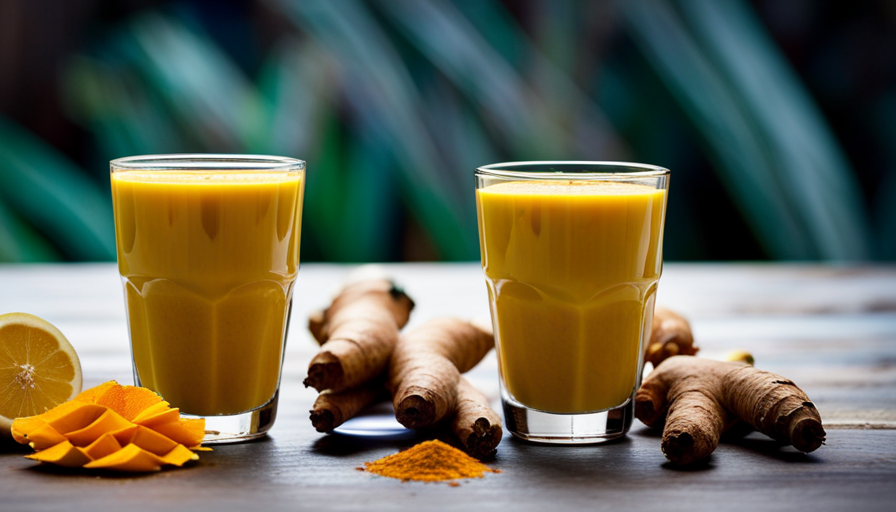Imagine waking up in the morning, eager to start your day, but as soon as you swing your legs out of bed, a wave of pain shoots through your knees and joints.
The simple act of walking or climbing stairs becomes a daunting task, limiting your mobility and hindering your quality of life.
If you find yourself in this situation, you are not alone. Knee and joint pain are common issues that affect millions of people worldwide.
Thankfully, nature has provided us with a potential solution – turmeric. Renowned for its vibrant color and distinct flavor, turmeric has also gained recognition for its anti-inflammatory properties.
But is turmeric truly effective in alleviating knee and joint pain?
In this article, we will explore the science behind turmeric’s anti-inflammatory properties, examine studies on its effectiveness, discover how to incorporate it into our daily routines, and explore potential side effects and precautions.
So, let’s dive in and uncover the potential benefits of turmeric for knee and joint pain.
Key Takeaways
- Turmeric, specifically its compound curcumin, has anti-inflammatory properties that can potentially help alleviate knee and joint pain.
- Turmeric supplements with black pepper may enhance absorption and maximize the benefits of curcumin.
- Studies have shown that turmeric supplementation can lead to a decrease in pain levels and an increase in joint function.
- Other natural remedies such as ginger, omega-3 fatty acids, and boswellia can also be beneficial in reducing inflammation and alleviating knee and joint pain.
The Science Behind Turmeric’s Anti-Inflammatory Properties
You’re going to love learning about the amazing science behind turmeric’s anti-inflammatory properties and how it can help ease your knee and joint pain! Turmeric, a bright yellow spice commonly used in Indian cuisine, contains a bioactive compound called curcumin. Curcumin has been extensively studied for its potential health benefits, including its anti-inflammatory effects.
Research suggests that curcumin can inhibit certain molecules that play a role in inflammation, making it a promising natural remedy for various health conditions. In addition to its anti-inflammatory properties, turmeric has also been studied for its potential effects on other health conditions such as cancer, diabetes, and heart disease. However, more research is needed to fully understand the extent of its benefits in these areas.
When it comes to using turmeric for knee and joint pain, dosage and timing recommendations can vary. Some studies have suggested that taking turmeric supplements with black pepper can enhance its absorption. It’s generally recommended to take turmeric with meals to maximize its effectiveness.
Now, let’s delve into the studies on the effectiveness of turmeric for knee and joint pain.
Studies on the Effectiveness of Turmeric for Knee and Joint Pain
In this discussion, we’ll examine studies on the effectiveness of turmeric for knee and joint pain. We’ll focus on three key points: reduction in inflammatory markers, improvement in pain, and enhancement of function.
These studies have provided evidence of turmeric’s ability to reduce inflammation by targeting specific markers associated with inflammation. They have also shown that turmeric supplementation can lead to a decrease in pain levels and an increase in overall joint function. This makes it a promising natural remedy for individuals suffering from knee and joint pain.
Reduction in Inflammatory Markers
Turmeric’s benefits extend beyond its vibrant color, as it can help alleviate knee and joint pain by reducing inflammatory markers. Inflammation plays a significant role in the development and progression of knee and joint pain. Research has shown that certain dietary factors can increase inflammation, while others can help reduce it.
A healthy diet rich in fruits, vegetables, whole grains, and lean proteins can play a crucial role in reducing inflammatory markers. Additionally, regular exercise has been shown to have a positive impact on inflammatory markers. Engaging in activities such as walking, swimming, or cycling can help decrease inflammation in the body.
By incorporating turmeric into your diet and engaging in regular exercise, you can effectively reduce inflammation and experience an improvement in pain and function.
Improvement in Pain and Function
By incorporating turmeric into your diet and engaging in regular exercise, you can effectively improve your overall mobility and daily activities. Here are four ways in which turmeric and exercise can benefit your knee and joint pain:
-
Reduced inflammation: Turmeric contains curcumin, a compound known for its anti-inflammatory properties. It can help decrease inflammation in the joints, reducing pain and swelling.
-
Enhanced joint function: Regular exercise, such as low-impact activities like walking or swimming, helps strengthen the muscles around the joints, providing better support and stability. This can lead to improved joint function and reduced pain.
-
Increased flexibility: Exercise helps improve flexibility, allowing for better range of motion in the joints. This can make daily activities easier and reduce discomfort.
-
Alternative treatment option: Incorporating turmeric into your diet offers a natural and holistic approach to managing knee and joint pain. It can be a valuable addition to other treatment modalities.
By understanding the benefits of turmeric and exercise, you can learn how to incorporate turmeric into your daily routine for optimal joint health and pain management.
How to Incorporate Turmeric into Your Daily Routine
Add a pinch of turmeric to your morning smoothie or sprinkle it onto your avocado toast for a delicious and easy way to incorporate this powerful anti-inflammatory spice into your daily routine. Turmeric has been used for centuries in traditional medicine for its numerous health benefits, including its potential to reduce knee and joint pain.
It can be incorporated into recipes such as curries, soups, and stir-fries, enhancing both the flavor and the health benefits of your meals. Additionally, turmeric supplements are available for those who prefer a more concentrated form of the spice. However, it’s important to note that while turmeric is generally safe for most people, it may interact with certain medications and should be used with caution.
In the next section, we’ll discuss potential side effects and precautions to consider when using turmeric for knee and joint pain relief.
Potential Side Effects and Precautions
To ensure your safety, it’s important to be aware of the potential side effects and precautions when incorporating turmeric into your daily routine. For example, if you’re taking blood thinners, it’s recommended to consult with your doctor before adding turmeric to your diet to avoid any potential interactions. Here are three important considerations to keep in mind:
-
Potential risks: While turmeric is generally safe for most people when consumed in moderation, high doses or long-term use may lead to gastrointestinal issues such as indigestion or diarrhea. It may also cause allergic reactions in some individuals.
-
Dosage guidelines: It’s crucial to follow the recommended dosage guidelines for turmeric supplements or when using it in cooking. Excessive consumption may have negative effects on the liver or gallbladder.
-
Precautions: Pregnant women, individuals with gallbladder problems, or those scheduled for surgery should exercise caution when using turmeric.
Understanding these potential risks and dosage guidelines can help you make informed decisions when incorporating turmeric into your routine.
Moving forward, let’s explore other natural remedies for knee and joint pain.
Other Natural Remedies for Knee and Joint Pain
When it comes to finding natural remedies for knee and joint pain, there are several options worth considering. Ginger, for example, has been shown to have anti-inflammatory properties that may help alleviate pain.
Omega-3 fatty acids, found in fish like salmon and sardines, have also been found to reduce joint stiffness and inflammation.
Additionally, boswellia, a resin extract from a tree, has been used in traditional medicine for its potential anti-inflammatory effects.
Considering these natural remedies could be a helpful addition to one’s pain management routine.
Ginger
Ginger is a fantastic natural remedy for knee and joint pain. It’s got numerous benefits that can help alleviate discomfort and improve mobility. One popular way to consume ginger is through ginger tea, which can be easily made by boiling fresh ginger slices in water. Here are three reasons why ginger is beneficial for knee and joint pain:
- Ginger has anti-inflammatory properties, reducing swelling and pain in the joints.
- Ginger has analgesic properties that can help relieve pain associated with knee and joint conditions.
- Ginger improves blood circulation, which can help reduce stiffness and promote healing in the affected areas.
Transitioning into the next section, another natural remedy for knee and joint pain is omega-3 fatty acids, which’ve been shown to have anti-inflammatory effects.
Omega-3 Fatty Acids
Omega-3 fatty acids, known for their inflammation-fighting properties, can be a game-changer when it comes to soothing discomfort in your knees and joints. Research has shown that these essential fats help reduce inflammation, which is a key factor in joint pain. In fact, studies have found that omega-3 supplementation can decrease the production of inflammatory markers in the body. Additionally, omega-3 fatty acids have been found to support joint health by promoting the production of cartilage and reducing the breakdown of joint tissues. Incorporating omega-3-rich foods like fatty fish, flaxseeds, and walnuts into your diet can provide these beneficial fats. Considering their potential for inflammation reduction and joint health support, it’s no wonder omega-3 fatty acids are often recommended for individuals with knee and joint pain. Moving forward, let’s explore another natural remedy, boswellia, that can also help alleviate discomfort without any side effects.
Boswellia
Boswellia, also known as Indian frankincense, can be an effective natural remedy to soothe discomfort and promote joint health. Research suggests that boswellia supplements may help reduce inflammation and pain associated with knee and joint issues.
Several studies have shown that the active compounds in boswellia, known as boswellic acids, can inhibit the production of inflammatory molecules in the body. This can help alleviate symptoms and improve overall joint function. Additionally, boswellia has been found to have minimal side effects compared to traditional pain medications.
These findings highlight the potential of boswellia as a complementary treatment for knee and joint pain.
Moving forward, let’s explore recommendations for using turmeric for knee and joint pain.
Recommendations for Using Turmeric for Knee and Joint Pain
For those seeking natural remedies, incorporating turmeric into your diet may offer relief for knee and joint pain. It provides a potential solution worth considering as turmeric contains a compound called curcumin, which has anti-inflammatory properties. These properties can help reduce pain and inflammation in the joints.
One way to incorporate turmeric into your diet is by adding it to your recipes. You can sprinkle turmeric powder onto roasted vegetables or mix it into soups and stews for an added health boost. Another option is to take turmeric supplements, which are available in capsule or tablet form.
It’s important to note that the effectiveness of turmeric may vary from person to person, so it’s best to consult with a healthcare professional before making any changes to your treatment plan.
In conclusion, turmeric has the potential to provide relief for knee and joint pain. However, further research is needed to fully understand its benefits.
Conclusion: The Potential Benefits of Turmeric for Knee and Joint Pain
If you think finding a natural solution to your knee and joint discomfort is as easy as taking a magic pill, think again. While turmeric supplements have shown potential benefits for knee and joint pain, it’s important to understand the proper dosage for turmeric to maximize its effects.
Research suggests that the active ingredient in turmeric, curcumin, has anti-inflammatory properties that may help reduce pain and swelling associated with knee and joint issues. However, the dosage of turmeric needed to achieve these benefits can vary depending on the individual and the severity of their pain. It’s recommended to start with a low dosage and gradually increase it if needed.
Additionally, it’s important to consult with a healthcare professional before starting any new supplement regimen, especially if you have underlying health conditions or are taking other medications. While turmeric may offer some relief for knee and joint pain, it’s essential to approach it with caution and follow proper guidelines for optimal results.
Frequently Asked Questions
Are there any interactions between turmeric and other medications or supplements?
There may be interactions between turmeric and blood thinners, which can increase the risk of bleeding. Turmeric can also cause potential side effects on the digestive system, such as stomach upset or diarrhea.
Can turmeric help with other types of pain besides knee and joint pain?
Turmeric has been found to be effective in reducing back pain. Studies have shown that curcumin, the active compound in turmeric, has anti-inflammatory and analgesic properties that can provide relief. Additionally, turmeric may also help with migraine relief.
How long does it take for turmeric to show its effects on knee and joint pain?
The effectiveness of turmeric in reducing knee and joint pain varies among individuals and can be influenced by factors such as dosage, duration of use, and overall health. It may take weeks or even months to experience noticeable effects.
Can turmeric be used as a substitute for traditional medical treatments for knee and joint pain?
Turmeric, a natural remedy, has shown effectiveness in pain relief. However, it should not be used as a substitute for traditional medical treatments for knee and joint pain. Always consult with a healthcare professional for proper diagnosis and treatment options.
Is it safe to consume turmeric in large amounts on a regular basis for long-term use?
Consuming large amounts of turmeric on a regular basis may have long-term effects. It is important to follow dosage recommendations, as excessive intake can lead to gastrointestinal issues and interfere with certain medications.
Conclusion
After reviewing the scientific evidence, it’s clear that turmeric holds great potential in relieving knee and joint pain. Its anti-inflammatory properties have been studied extensively, showing promising results.
By incorporating turmeric into our daily routine, whether through supplements or in cooking, we can harness its benefits. However, it’s important to note that turmeric may not work for everyone, and there can be potential side effects. It’s always wise to consult with a healthcare professional before starting any new treatment.
Overall, turmeric offers a natural and evidence-based option for those seeking relief from knee and joint pain.









